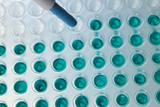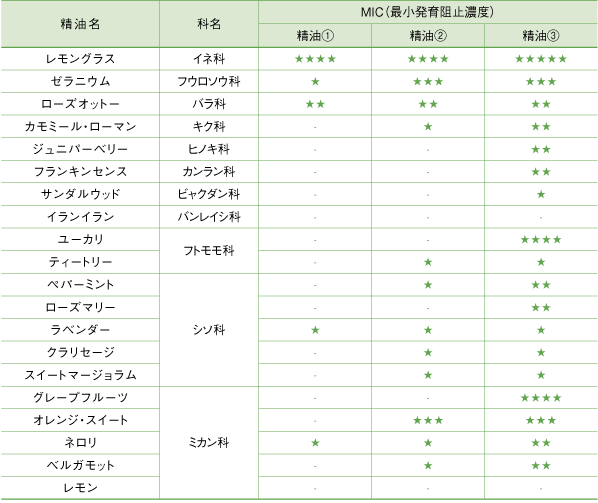アロマテラピー検定・資格の認定、学術調査研究の実施

- アロマを楽しむ
- アロマの研究・調査
- アロマサイエンス研究所
- カンジダ菌の増殖を抑える精油
抗菌|Antibacterial
カンジダ菌の増殖を抑える精油

精油が真菌(キノコ、カビ、酵母の仲間)や細菌の増殖を抑制することについて、これまで多くの研究が行われてきました。真菌の一種であるカンジダ菌は、皮膚や粘膜に炎症を引き起こす菌で、健康な人にも見つかりますが、病気などで免疫力が低い状態にある人が「カンジダ症」を発症することがあります。今回は、20種類の精油のカンジダ菌に対する抗真菌活性を、微生物が増殖できない精油濃度の最小値(最小発育阻止濃度、MIC)で調べた結果をご紹介します。
同じ植物の精油でも商品によって抗真菌活性に大きな差がある精油もありますが、レモングラス精油、ユーカリ精油、グレープフルーツ精油、ゼラニウム精油、オレンジ・スイート精油において、比較的高い抗真菌活性が示されています。
実験方法
| 対象 | Candida属真菌(Candida albicans) |
|---|---|
| 精油 | 20種類。各精油につき、3社の異なる商品を使用。 |
| 方法 | マイクロプレートを用いた「微量液体希釈法」により、界面活性剤の有り無しそれぞれの条件のもと、各精油についてMICを算出。 |

(イメージ図)
【マイクロプレート(96穴プレート)】
マイクロプレートは、多数のくぼみを試験管あるいはシャーレとして利用するもの。くぼみの数には6、24、96、384などがあり、これを試験に使うことで操作および結果比較が容易になっている。
【微量液体希釈法】
異なる液体濃度で微生物を培養し、その液体に対する抵抗性を観察する方法。本実験では、精油を使用しています。

3社の精油で比較した抗真菌活性の実験結果

●界面活性剤を添加しない条件におけるMIC(%)の数値に基づく。
反応ナシ=‐ ★=2 ★★=1 ★★★=0.5 ★★★★=0.25 ★★★★★=0.125
※★が多い(MICが小さい)ほど効果が強い。
●異なる3社の精油のMICを、精油①が最も大きく、精油③が最も小さくなるような順で並べている。
(例:ペパーミント精油において精油①・②・③がそれぞれA社・B社・C社だとしても、ローズマリー精油ではB社・C社・A社となる可能性がある。)
論文:松崎友祐, 他 (2015) 20種類の精油におけるCandida albicansに対する抗真菌活性. アロマテラピー学雑誌15(1):78-87.
Abstract: Fungi belonging to the genus Candida are responsible for opportunistic infectious
diseases including oral candidiasis, which causes oral pain. In the case of the elderly who require nursing
care, the adherence of C. albicans to denture surfaces is considered to be the cause of the symptoms. We
examined whether essential oils could be used as cleaning agents of C. albicans-infected dentures. We selected
20 kinds of essential oils from three different manufactures, and two surfactants, Tween 80 and Tween 20. The
antifungal activities of the 60 essential oils in total were studied under three conditions: addition of Tween
80, Tween 20, and no surfactant. The evaluation was made based on minimal inhibitory concentration (MIC) values
determined by standardized antibiotic susceptibility testing. After the confirmation of MIC values, the minimal
fungicidal concentration (MFC) values were also examined. More than half of the essential oils were fungicidally
active without surfactants; however, the number was increased with the addition of surfactants, exhibiting the
fungicidal activities at lower concentrations. Among the oils tested, lemongrass showed the lowest MIC, with a
concentration less than 0.016%. The fungicidal activities in some essential oils of the same species varied
among manufacturers. It was also found that Tween 20 was more effective than Tween 80 at amplifying the
fungicidal activities of essential oils at lower concentrations. The results of this study provide evidence that
some essential oils are effective as new denture-cleaning agents. In selecting essential oils for cleansing
agents, it is important to identify the most effective oil types, even of the same name or species, and to
choose the most suitable surfactant.
Key words: essential oil, oral candidiasis, Candida albicans, Tween 80, Tween 20


 アロマで毎日を私らしく
アロマで毎日を私らしく